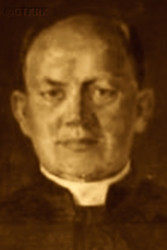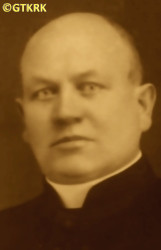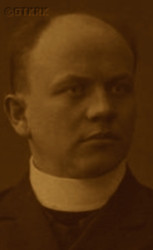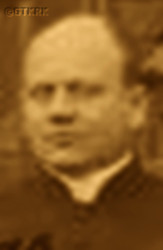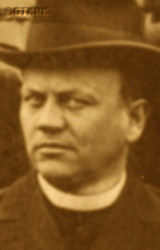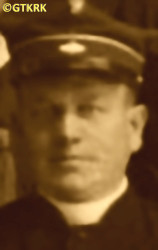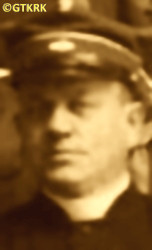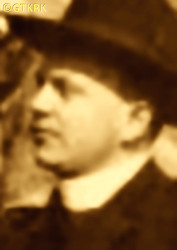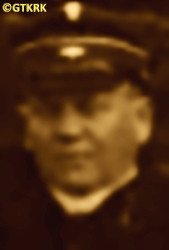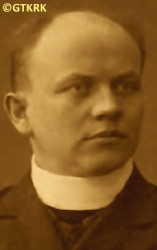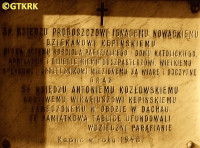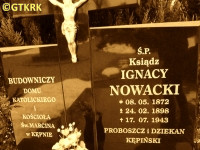Roman Catholic
St Sigismund parish
05-507 Słomczyn
85 Wiślana Str.
Konstancin deanery
Warsaw archdiocese, Poland
full list:
displayClick to display full list

searchClick to search full list by categories
wyświetlKliknij by wyświetlić pełną listę po polsku

szukajKliknij by przeszukać listę wg kategorii po polsku

Martyrology of the clergy — Poland
XX century (1914 – 1989)
personal data
surname
NOWACKI
forename(s)
Ignatius (pl. Ignacy)
function
diocesan priest
creed
Latin (Roman Catholic) Church RCmore on
en.wikipedia.org
[access: 2014.09.21]
diocese / province
Gniezno and Poznań archdiocese (aeque principaliter)more on
www.archpoznan.pl
[access: 2012.11.23]
RC Military Ordinariate of Polandmore on
en.wikipedia.org
[access: 2014.12.20]
honorary titles
„Cross of Independence”more on
en.wikipedia.org
[access: 2019.02.02]
(20.07.1932)
Gold „Cross of Merit”more on
en.wikipedia.org
[access: 2019.04.16]
(09.11.1932)
Honorary Badge of the Polish Red Cross — 1st Class
date and place
of death
14.07.1943

Kalisztoday: Kalisz city pov., Greater Poland voiv., Poland
more on
en.wikipedia.org
[access: 2020.12.16]
details of death
During the Prussian partition (one of three partitions of Poland), as a student of the Germ. Königliches Gymnasium (Eng. Royal Gymnasium) in Wągrowiec, was a member of the clandestine, Polish self–education Thomas Zan Society. For possession of „illegal” Polish books, expelled from the gymnasium (continued his education in Leipzig, where became one of the co‐founders of the Catholic Society of Polish Workers KTRP, founded in 1893, modelled on a similar association founded that same year in Poznań).
While ministering in Ostrów Wielkopolski, was the founder of the clandestine self–education Thomas Zan Society and clandestine Polish language courses for students of the local Germ. Königliches Gymnasium (Eng. Royal Gymnasium).
In 1906, supported a strike of Polish school children demanding among others of holding catechesis in Polish. Sentenced by the Prussian authorities to a fine of 200 German marks or 20 days in prison, plus trial costs.
Fined several times — i.a. for having Polish banners, including the KTRP banners, and Polish inscriptions on them, marches and public calls for disobedience against the orders of the German authorities, and inciting to rebel.
At the end of World War I, in 1918 in Kępno, organised a clandesting Polish Scout movement — the first 7‐person troop was formed at that time.
After the abdication on 09.11.1918 of the German Emperor William II Hohenzollern; after the armistice and ceasefire between the Allies and Germany signed on 11.11.1918 in a staff wagon in Compiègne, in the headquarters of French Marshal Ferdinand Foch — which de facto meant the end of World War I; and also after the transfer on the same day by the Regency Council established by the Germans — operating in the territory occupied by Germany and Austria–Hungary of the so‐called Germ. Königreich Polen (Eng. Polish Kingdom) — supreme military authority to Brigadier Joseph Piłsudski and his appointment as Commander‐in‐Chief of the Polish Army, which de facto meant the rebirth of the Polish state, encompassing however only the area of Germ. Königreich Polen, i.e. part of Poland until 1914 under Russian rule, and not encompassing the lands of the Prussian partition, which were still under German control; on 16.11.1918 became the president of the Polish District People's Council, established at the appeal of the Supreme People's Council NRL established two days earlier in Poznań.
Was one of 431 delegates to the Polish District Parliament, which met on 03‐05.12.1918 in Poznań, and which expressed the will to create a united Polish state with access to the sea, encompassing the Polish lands of the former Prussian partition, and recognized the NRL as the Polish legal state authority.
The Germans, who still exercised military power over the entire area of the Prussian partition, of course did not accept this. That is why the Greater Poland Uprising broke out on 27.12.1918. At this news, the Germans in Kępno, strengthened by the military presence of a unit of the Germ. Grenzschutz Ost (Eng. Eastern Border Guard), a paramilitary volunteer formation opposing the separation of the eastern territories from Germany, reinforced by units from Wrocław, next day on 28.12.1918 began to tear off the national cockades of the Poles, forbidding them to wear Polish badges, and to attack them. However, the District People's Council did not let itself be provoked and did not take up arms, limiting itself to collecting funds for the national fund and purchasing weapons, and sending the youth to other fronts of the uprising. Among other places, they fought in the vicinity of Ostrzeszów, c. 18 km from Kępno, which the Poles captured and held on to. On 10.01.1919 was brought before the Germ. Grenzschutz Ost court and the Germans searched the rectory in search of weapons. No weapons were found, but from Monday 13.01.1919, was placed under house arrest. Three days later was arrested again, together with 5 other members of the People's Council. Released, but remained under house arrest until 05.03.1919, forced to report daily to the local guardhouse. On 16.02.1919 the Uprising ended with the armistice in Trier, enforced by the victorious Entente states, by virtue of which the Polish insurgent Greater Poland Army was recognized as an allied army and a border was set, which „German troops were forbidden to cross”, leaving Greater Poland outside their influence. However, since no date was set for the provisions of the armistice to come into force, local clashes continued. And on 20.06.20, 1919, was arrested by the Germans yet again and imprisoned in the IL Neuhammer internment camp. Six days later, on 26.06.1919, the Treaty of Versailles was concluded, which awarded Greater Poland to Poland. Despite this, was not released from the camp until 30.06.1919.
The Treaty of Versailles came into force on 10.01.1920 and a week later, on 17.01.1920, soldiers of the 11th Greater Poland Rifle Regiment entered Kępno. The town returned to Poland. The next day celebrated a solemn Holy Mass in the market square.
Then, during the Polish–Russian War of 1919‐1921, as he wrote, „bought and sent to the front food, disinfectants, medicines, bandages and dressings, medical instruments, and donated a medical wagon equipped with all this on behalf of the citizens of Kępno to the Poznań District Command of the Polish Army”.
After the German and Russian invasion of the Republic of Poland in 09.1939 and the beginning of World War II, after start of the German occupation, arrested by the Germans on 03.09.1939.
Held in prisons in Kępno, Wrocław (from 07.09.1939), Rawicz (from 10.09.1939).
Released on 17.10.1939.
Arrested again after three days.
Released after a week.
Arrested a third time on 04.11.1939.
Held in prison in Kalisz.
Released on 20.03.1940 with a ban on returning to Kępno.
Exiled to the Rypinek district of Kalisz, where its church was the only one made available to Polish residents of Kalisz and the surrounding area by the Germans. Prob. replaced the parish priest there and celebrated the only Sunday Holy Mass in Polish, behind closed doors. As a „prize” received from the Germans an „old, clattering hearse” in which carried deceased Poles on their last journey.
Fell ill with pneumonia. Perished in hospital.
cause of death
extermination: exhaustion and disease
perpetrators
Germans
sites and events
KaliszClick to display the description, RawiczClick to display the description, Reichsgau WarthelandClick to display the description, «Intelligenzaktion»Click to display the description, Ribbentrop‐MolotovClick to display the description, Pius XI's encyclicalsClick to display the description, NeuhammerClick to display the description, Greater Poland UprisingClick to display the description, Thomas Zan SocietiesClick to display the description
date and place
of birth
08.05.1872

Żernikitoday: Janowiec Wielkopolski gm., Żnin pov., Kuyavia‐Pomerania voiv., Poland
more on
en.wikipedia.org
[access: 2021.07.18]
parents
NOWACKI Joseph
🞲 ?, ? — 🕆 ?, ?

SKOCZYŃSKA Catherine
🞲 ?, ? — 🕆 ?, ?
baptism

Żernikitoday: Janowiec Wielkopolski gm., Żnin pov., Kuyavia‐Pomerania voiv., Poland
more on
en.wikipedia.org
[access: 2021.07.18]
Nativity of the Blessed Virgin Mary RC church
presbyter (holy orders)
ordination
24.02.1898

positions held
1940 – 1943
resident — KaliszRypinek neighborhood
today: Kalisz city pov., Greater Poland voiv., Poland
more on
en.wikipedia.org
[access: 2020.12.16] ⋄ St Gothard from Hildesheim the Bishop and Prior RC parish ⋄ North Kaliszdeanery name
today: Kalisz city pov., Greater Poland voiv., Poland
more on
en.wikipedia.org
[access: 2020.12.16] RC deanery
1933 – 1939
dean — Kępnotoday: Kępno gm., Kępno pov., Greater Poland voiv., Poland
more on
en.wikipedia.org
[access: 2021.05.30] RC deanery
1909 – 1939
parish priest — Kępnotoday: Kępno gm., Kępno pov., Greater Poland voiv., Poland
more on
en.wikipedia.org
[access: 2021.05.30] ⋄ St Martin the Bishop and Confessor RC parish ⋄ Kępnotoday: Kępno gm., Kępno pov., Greater Poland voiv., Poland
more on
en.wikipedia.org
[access: 2021.05.30] RC deanery — also: prefect c. 1926‐1929 at the Gymnasium for Girls, till c. 1922 at the Gymnasium for Boys (from 1920 State Gymnasium, 1912‐1920 Classical Gymnasium); member c. 1931‐1938 of the Lat. Lat. „Consilium a Vigilantiae” (Eng. „Committee on Morals”) of the Archdiocesan Curia; c. 1929‐1939 inspector of religion classes in elementary schools in the district/region; c. 1922‐1933 second dean's assessor, i.e. assistant to the dean in the exercise of his office; honorary president of the Kępno branch of the Polish Red Cross (PCK); organizer of the Red Cross organisation (transformed c. 1920 as the Polish Red Cross); member of the supervisory board of the People's Bank in Kępno; member of the Council of the Young Polish Women's Association in Poznań
1901 – 1909
administrator — Kępnotoday: Kępno gm., Kępno pov., Greater Poland voiv., Poland
more on
en.wikipedia.org
[access: 2021.05.30] ⋄ St Martin the Bishop and Confessor RC parish ⋄ Kępnotoday: Kępno gm., Kępno pov., Greater Poland voiv., Poland
more on
en.wikipedia.org
[access: 2021.05.30] RC deanery — also: prefect of the gymnasium
1898 – 1901
vicar — Ostrów Wielkopolskitoday: Ostrów Wielkopolski urban gm., Ostrów Wielkopolski pov., Greater Poland voiv., Poland
more on
en.wikipedia.org
[access: 2021.06.07] ⋄ St Stanislav the Bishop and Martyr RC parish ⋄ Ostrów Wielkopolskitoday: Ostrów Wielkopolski urban gm., Ostrów Wielkopolski pov., Greater Poland voiv., Poland
more on
en.wikipedia.org
[access: 2021.06.07] RC deanery — also: prefect of the gymnasium
1897 – 1898
student — Gnieznotoday: Gniezno urban gm., Gniezno pov., Greater Poland voiv., Poland
more on
en.wikipedia.org
[access: 2021.12.18] ⋄ philosophy and theology, Archbishop's Practical Theological Seminary (Lat. Seminarium Clericorum Practicum)
1894 – 1897
student — Poznańtoday: Poznań city pov., Greater Poland voiv., Poland
more on
en.wikipedia.org
[access: 2021.07.18] ⋄ philosophy and theology, Archbishop's Theological Seminary (Collegium Leoninum)
from 1916
membership — Poznańtoday: Poznań city pov., Greater Poland voiv., Poland
more on
en.wikipedia.org
[access: 2021.07.18] ⋄ Friends of Sciences Society
sites and events
descriptions
Kalisz: Prison for men and women built in 1840‐1846, during the Russian occupation. It consisted of c. 120 individual cells. After the outbreak of World War II and start of German occupation, it was a pre‐trial detention center and a prison — initially Germ. Gefängnis (Eng. prison), from 10.03.1941 Germ. Haftanstalt (Eng. jail), from 01.1942 Germ. Stammlager/Haftanstalt (Eng. main penal camp / jail) — administered by the German Germ. Geheime Staatspolizei (Eng. Secret State Police), i.e. Gestapo. Mainly Poles, but also Germans, including those considered to be political prisoners (members of the Polish resistance movement), were held there. Inmates — if they were not murdered as a result of torture or sentenced to death — were next transported to concentration camps. The prison was overcrowded — e.g. on 30.04.1943, 422 men and 126 women were held there. The prisoners were tortured. From 18.09.1942, death sentences were carried out on Poles — c. 700 people were murdered in total (shot, hanged, and those who died as a result of torture and diseases). In total, over 15,000 people passed through the prison between 1939 and 1945. After the German defeat and the start of the Russian occupation, the prison was run by the Commie‐Nazi UB, a unit of the genocidal Russian MGB. In 12.1952, 599 people were detained there — some of them soldiers of the clandestine Greater Poland Independent Volunteer Group WARTA and the NSZ, as well as pre—war Polish policemen, and young high school students opposing the Russian occupation. (more on: sw.gov.plClick to attempt to display webpage
[access: 2022.08.17], www.szukajwarchiwach.gov.plClick to attempt to display webpage
[access: 2024.12.13])
Rawicz: Prison, founded in 1819‐1821, in place of the Franciscan Friars Minor's monastery, which was liquidated by the Prussian occupation authorities. During the World War II, during the German occupation of 1939‐1945, the German Germ. Zuchthaus (Eng. heavy prison), intended for men sentenced to long‐term imprisonment and penal camp sentences, levied mainly by the Germ. Warthegau (Eng. Wartha region) occupation courts. A large part of the prisoners were next transported from there to German concentration camps. After the end of the military operations of World War II, the prison was managed by the Commie‐Nazi authorities of the Russian prl republic. Many activists of the Polish clandestine independence underground were detained there, including soldiers of the Home Army AK. Political prisoners were finally released in 1956. (more on: pl.wikipedia.orgClick to attempt to display webpage
[access: 2013.08.17])
Reichsgau Wartheland: After the Polish defeat in the 09.1939 campaign, which was the result of the Ribbentrop‐Molotov Pact and constituted the first stage of World War II, and the beginning of German occupation in part of Poland (in the other, eastern part of Poland, the Russian occupation began), the Germans divided the occupied Polish territory into five main regions (and a few smaller). The largest one was transformed into Germ. Generalgouvernement (Eng. General Governorate), intended exclusively for Poles and Jews and constituting part of the so‐called Germ. Großdeutschland (Eng. Greater Germany). Two were added to existing German provinces. From two other separate new provinces were created. Greater Poland region was one of them, incorporated into Germany on 08.10.1939, by decree of the German leader Adolf Hitler (formally came into force on 26.10.1939), and on 24.01.1940 transformed into the Germ. Reichsgau Wartheland (Eng. Wartheland Reich Province), in which the law of the German state was to apply. The main axis of the policy of the new province, the territory of which the Germans recognized as the Germ. „Ursprünglich Deutsche” (Eng. „natively German”), despite the fact that 90% of its inhabitants were Poles, was Germ. „Entpolonisierung” (Eng. „Depolonisation”), i.e. forced Germanization. C. 100,000 Poles were murdered as part of the Germ. „Intelligenzaktion”, i.e. extermination of Polish intelligentsia and ruling classes. C. 630,000 were forcibly resettled to the Germ. Generalgouvernement, and their place taken by the Germans brought from other areas occupied by Germany (e.g. the Baltic countries, Bessarabia, Bukovina, etc.). Poles were forced to sign the German nationality list, the Germ. Deutsche Volksliste DVL. As part of the policy of „Ohne Gott, ohne Religion, ohne Priesters und Sakramenten” (Eng. „No God, no religion, no priest or sacrament”) most Catholic priests were arrested and sent to concentration camps. All schools teaching in Polish, Polish libraries, theaters and museums were closed. Polish landed estates confiscated. To further reduce the number of the Polish population, Poles were sent to forced labor deep inside Germany, and the legal age of marriage for Poles was increased (25 for women, 28 for men). The German state office, Germ. Rasse‐ und Siedlungshauptamt (Eng. Main Office of Race and Settlement) RuSHA, under the majesty of German law, abducted several thousand children who met specific racial criteria from Polish families and subjected them to forced Germanization, handing them over to German families. After the end of hostilities of World War II, the overseer of this province, the Germ. Reichsstatthalter (Eng. Reich Governor) and the Germ. Gauleiter (Eng. district head) of the German National Socialist Party, Arthur Karl Greiser, was executed. (more on: en.wikipedia.orgClick to attempt to display webpage
[access: 2024.06.21])
«Intelligenzaktion»: German: «Intelligenzaktion» (English: „Intelligence Action”) — a German program of extermination of the Polish elite, mainly the intelligentsia and leadership layers, carried out from the beginning of the occupation in w 09.1939 to 04.1940, mainly in territories directly annexed to Germany, but also in the so‐called Germ. Generalgouvernement (Eng. General Governorate), where it was called «AB‐aktion». In the first phase, immediately after the beginning of the German occupation, during military operations carried out by the Germ. Wehrmacht (Eng. Armed Forces) and the genocidal units of the Germ. Einsatzgruppen (Eng. Operational Groups) of the Germ. Sicherheitspolizei (Eng. Security Police), i.e. SiPo, and Germ. Sicherheitsdienst des Reichsführers SS (Eng. Security Service of the Reichsführer SS), i.e. SD, organized by the Germ. Reichssicherheitshauptamt (Eng. Reich Main Security Office), i.e. RSHA, which followed the troops, carried out under the Germ. Unternehmen „Tannenberg” (Eng. Operation „Tannenberg”) — based on the so‐called Germ. Sonderfahndungsliste (Eng. Special Wanted Lists), i.e. proscription lists of Poles considered particularly dangerous to the Third Reich, prepared by the Zentralstelle II/P (Polen) unit of the German RSHA. Later, implemented by the German civilian occupation authorities and the genocidal unit of the Germ. Volksdeutscher Selbstschutz (Eng. Ethnic Germans Self‐Defense), whose members were Germ. Volksdeutsche (Eng. Ethnic Germans), i.e. representatives of the German minority in Poland. According to various sources, these lists, at the beginning of 09.1939, could have contained the details of 61,000—88,000 „dangerous” Poles — although these figures cannot be confirmed. In total, during this genocide, c. 50,000 teachers, Catholic priests, representatives of the landed gentry, freelancers, social and political activists, and retired military personnel were systematically and methodically murdered. Another 50,000 were sent to concentration camps, where only a negligible percentage survived. (more on: en.wikipedia.orgClick to attempt to display webpage
[access: 2014.10.04])
Ribbentrop‐Molotov: Genocidal Russian‐German alliance pact between Russian leader Joseph Stalin and German leader Adolf Hitler signed on 23.08.1939 in Moscow by respective foreign ministers, Mr. Vyacheslav Molotov for Russia and Joachim von Ribbentrop for Germany. The pact sanctioned and was the direct cause of joint Russian and German invasion of Poland and the outbreak of the World War II in 09.1939. In a political sense, the pact was an attempt to restore the status quo ante before 1914, with one exception, namely the „commercial” exchange of the so‐called „Kingdom of Poland”, which in 1914 was part of the Russian Empire, fore Eastern Galicia (today's western Ukraine), in 1914 belonging to the Austro‐Hungarian Empire. Galicia, including Lviv, was to be taken over by the Russians, the „Kingdom of Poland” — under the name of the General Governorate — Germany. The resultant „war was one of the greatest calamities and dramas of humanity in history, for two atheistic and anti‐Christian ideologies — national and international socialism — rejected God and His fifth Decalogue commandment: Thou shall not kill!” (Abp Stanislav Gądecki, 01.09.2019). The decisions taken — backed up by the betrayal of the formal allies of Poland, France and Germany, which on 12.09.1939, at a joint conference in Abbeville, decided not to provide aid to attacked Poland and not to take military action against Germany (a clear breach of treaty obligations with Poland) — were on 28.09.1939 slightly altered and made more precise when a treaty on „German‐Russian boundaries and friendship” was agreed by the same murderous signatories. One of its findings was establishment of spheres of influence in Central and Eastern Europe and in consequence IV partition of Poland. In one of its secret annexes agreed, that: „the Signatories will not tolerate on its respective territories any Polish propaganda that affects the territory of the other Side. On their respective territories they will suppress all such propaganda and inform each other of the measures taken to accomplish it”. The agreements resulted in a series of meeting between two genocidal organization representing both sides — German Gestapo and Russian NKVD when coordination of efforts to exterminate Polish intelligentsia and Polish leading classes (in Germany called «Intelligenzaktion», in Russia took the form of Katyń massacres) where discussed. Resulted in deaths of hundreds of thousands of Polish intelligentsia, including thousands of priests presented here, and tens of millions of ordinary people,. The results of this Russian‐German pact lasted till 1989 and are still in evidence even today. (more on: en.wikipedia.orgClick to attempt to display webpage
[access: 2015.09.30])
Pius XI's encyclicals: Facing the creation of two totalitarian systems in Europe, which seemed to compete with each other, though there were more similarities than contradictions between them, Pope Pius XI issued in 03.1937 (within 5 days) two encyclicals. In the „Mit brennender Sorge” (Eng. „With Burning Concern”) published on 14.03.1938, condemned the national socialism prevailing in Germany. The Pope wrote: „Whoever, following the old Germanic‐pre‐Christian beliefs, puts various impersonal fate in the place of a personal God, denies the wisdom of God and Providence […], whoever exalts earthly values: race or nation, or state, or state system, representatives of state power or other fundamental values of human society, […] and makes them the highest standard of all values, including religious ones, and idolizes them, this one […] is far from true faith in God and from a worldview corresponding to such faith”. On 19.03.1937, published „Divini Redemptoris” (Eng. „Divine Redeemer”), in which criticized Russian communism, dialectical materialism and the class struggle theory. The Pope wrote: „Communism deprives man of freedom, and therefore the spiritual basis of all life norms. It deprives the human person of all his dignity and any moral support with which he could resist the onslaught of blind passions […] This is the new gospel that Bolshevik and godless communism preaches as a message of salvation and redemption of humanity”… Pius XI demanded that the established human law be subjected to the natural law of God , recommended the implementation of the ideal of a Christian state and society, and called on Catholics to resist. Two years later, National Socialist Germany and Communist Russia came together and started World War II. (more on: www.vatican.vaClick to attempt to display webpage
[access: 2023.05.28], www.vatican.vaClick to attempt to display webpage
[access: 2023.05.28])
Neuhammer: During World War I (1914‐1918) in the vicinity of contemporary Świętoszów, Żagań and Konin Żagański Germans set up POW camp for Russian soldiers (up to 33,000 inmates). In 1919 in Germ. „Internierungslager” (Eng. „internment camp”) IL Neuhammer (i.e. Świętoszów) Greater Poland Uprising insurgents, including Polish priests, were held captive. During World War II Germans set up a Stalag VIII E Neuhammer POW camp for Polish, French captured soldiers, next Stalag 308 for Russian soldiers. Soldiers of other nationalities were also held captive (including Warsaw Uprising Polish combatants). At least 50,000 perished. On 13.02.1945, at camp liberation, at Stalag 308 only 200 Russian prisoners were found alive. 10 days later they were executed by Russian NKVD as Russian traitors. In 1945‐1954 camp was used as Russian NKVD maximum security prison. (more on: pl.wikipedia.orgClick to attempt to display webpage
[access: 2016.08.14], www.ziemialubuska.plClick to attempt to display webpage
[access: 2016.08.14])
Greater Poland Uprising: Military insurrection of Poles of former German Germ. Posen Provinz (Eng. Poznań province) launched against German Reich in 1918‐1919 — after the abdication on 09.11.1918 of the German Emperor William II Hohenzollern; after the armistice between the Allies and Germany signed on 11.1.1918 in the HQ wagon in Compiègne, the headquarters of Marshal of France Ferdinand Foch — which de facto meant the end of World War I — against the German Weimar Republic, established on the ruins of the German Empire, aiming to incorporate lands captured by Prussia during partitions of Poland in XVIII century into Poland. The Republic of Poland, reborn on 11.11.1918, initially formally included only the so‐called Germ. Königreich Polen (Eng. Kingdom of Poland), i.e. the territory that had been under Russian rule until 1915 and then under the control of Central States (Germany and Austria–Hungary), but did not include the Prussian partition. Started on 27.12.1918 in Poznań and ended on 16.02.1919 with the armistice pact in Trier, forced by the victorious Entente states, which included provisions ordering Germany to cease operations against Poland and, importantly, recognizing the Polish insurgent Greater Poland Army as an allied armed force of the Entente. De facto it turned out to be a Polish victory, confirmed in the main peace treaty after World War I, the Treaty of Versailles of 28.06.1919, which came into force on 10.01.1920 and in which most of the lands of the Prussian partition were recognized as Polish. Many Polish priests took part in the Uprising, both as chaplains of the insurgents units and members and leaders of the Polish agencies and councils set up in the areas covered by the Uprising. In 1939 after German invasion of Poland and start of the World War II those priests were particularly persecuted by the Germans and majority of them were murdered. (more on: en.wikipedia.orgClick to attempt to display webpage
[access: 2016.08.14])
Thomas Zan Societies: Secret societies of Polish youth, aiming at self‐education, patriotic in form and content, functioning 1830‐1920, in mutiny against enforced Germanisation and censure of Polish culture, mainly in secondary schools — gymnasia — mainly in Greater Poland (Wielkopolska) and later in Silesia. The first groups were formed in 1817. In 1897 a congress in Bydgoszcz was held when rules of clandestine activities were formulated. At other congress in Bydgoszcz in Poznań a „Red Rose” society was formed, heading all others groups in various gymnasiums and coordinating their activities. In 1900 „Red Rose” consolidated Philomaths organizations from Pomerania as well. After Toruń trial of Pomeranian Philomaths in Toruń Germans arrested 24 members of Thomas Zan Society from Gniezno. 21 of them were sentenced up to 6 weeks in prison and reprimands. All were relegated from schools without the right to continue education in secondary and higher schools in Prussia. Despite repression the Societies existed till 1918 and rebirth of Poland. (more on: pl.wikipedia.orgClick to attempt to display webpage
[access: 2021.12.19])
sources
personal:
www.bibliotekakepno.plClick to attempt to display webpage
[access: 2013.05.19], www.wtg-gniazdo.orgClick to attempt to display webpage
[access: 2013.05.19], ordynariat.wp.mil.plClick to attempt to display webpage
[access: 2024.12.13]
bibliographical:
„Martyrology of the Polish Roman Catholic clergy under nazi occupation in 1939‐1945”, Victor Jacewicz, John Woś, vol. I‐V, Warsaw Theological Academy, 1977‐1981
original images:
www.kepnosocjum.plClick to attempt to display webpage
[access: 2013.12.27], kepnosocjum.plClick to attempt to display webpage
[access: 2020.01.26], www.kepnosocjum.plClick to attempt to display webpage
[access: 2016.08.14], historialomzy.plClick to attempt to display webpage
[access: 2016.08.14], mzk.locloud.plClick to attempt to display webpage
[access: 2016.08.14], kepnosocjum.plClick to attempt to display webpage
[access: 2020.01.26], kepnosocjum.plClick to attempt to display webpage
[access: 2020.01.26], kepnosocjum.plClick to attempt to display webpage
[access: 2020.01.26], kepnosocjum.plClick to attempt to display webpage
[access: 2020.01.26], www.kepno.plClick to attempt to display webpage
[access: 2024.12.13], marcosbox.flog.plClick to attempt to display webpage
[access: 2019.10.13], kepnosocjum.plClick to attempt to display webpage
[access: 2020.01.26]
LETTER to CUSTODIAN/ADMINISTRATOR
If you have an Email client on your communicator/computer — such as Mozilla Thunderbird, Windows Mail or Microsoft Outlook, described at WikipediaPatrz:
en.wikipedia.org, among others — try the link below, please:
LETTER to CUSTODIAN/ADMINISTRATORClick and try to call your own Email client
If however you do not run such a client or the above link is not active please send an email to the Custodian/Administrator using your account — in your customary email/correspondence engine — at the following address:

giving the following as the subject:
MARTYROLOGY: NOWACKI Ignatius
To return to the biography press below:
 Click to return to biography
Click to return to biography








